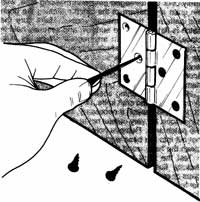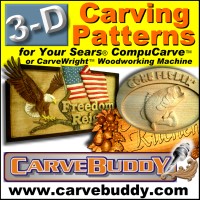The hardware on old furniture -- drawer pulls, handles, hinges, locks, protective corners, and decorative bands and escutcheons -- often shows signs of long, hard use. Sometimes hardware is missing; sometimes it's loose, broken, or bent. Loose hardware can be repaired; missing or damaged pieces should be replaced.
Replacement is also the solution if you don't like the existing hardware. In this section, we'll discuss some techniques to quickly replace or repair worn hardware on your wooden furniture so they work once more.
Many pieces of furniture are made with very common types of hardware; matching these basic designs is fairly simple. If the hardware is more distinctive or unusual, it may be easier to replace all the hardware than to find a matching piece; make sure the new hardware's bases are at least as large as the old.
But if the piece of furniture is very valuable or an antique, or if the hardware is very attractive, the old hardware should not be removed. In this case, missing parts should be replaced with matching or similar hardware; a slight difference in design usually doesn't look bad.
Hardware stores, home centers, and similar stores offer a fair selection of furniture hardware; specialty hardware outlets and craft suppliers are usually better sources. Search the Internet for hardware vendors. Let's get started by reviewing how to handle a common hardware problem -- loose drawer pulls and handles.
Drawer Pulls and Handles

 Publications International, Ltd.
Publications International, Ltd.
Enlarged screw holes can be made smaller
with wood toothpicks, glued in and
trimmed flush with the surface.
To tighten a loosely attached drawer pull, remove the pull and replace the screw with a longer one. If the screw is part of the pull, you'll have to make the hole in the wood smaller. When the hole is only slightly enlarged, you can tighten the pull by using a hollow fiber plug with the screw. For metal pulls, fit a piece of solid-core solder into the hole and then replace the screw.
When the hole is much too big, insert wood toothpicks or thin shavings of wood, with glue applied on the outside, into the hole. Let the glue dry and carefully trim them flush with the wood surface. Then dip the pull's screw into glue, replace the pull, and tighten the screw firmly. For a more substantial repair, enlarge the hole, glue a piece of dowel into it, and drill a new screw hole.
Hinges
Hinges that don't work properly usually have bent hinge pins; in this case, replace the hinges. If the hinges are loose, try using slightly longer screws to attach them. When the screw holes are very much enlarged, adjust them by one of the methods detailed above. If the hinge leaves are damaged and the hinges cannot be replaced, glue the hinges into position with epoxy or a rubber- or silicone-base adhesive.
Locks
Locks on old pieces are often damaged, and keys are often missing. If the piece of furniture is an antique, or the lock is very unusual, have it repaired by a professional. Otherwise, remove the damaged furniture lock and take it to a locksmith; order a matching or similar lock to replace it.
Loose Metal Bands and Escutcheons
Old bands and escutcheons often have an attractive design and patina; don't replace them unless they're badly damaged. To secure a loose band or escutcheon, squeeze adhesive caulking compound under the metal, and press it down to bond it to the wood. If this doesn't work, fasten the band or escutcheon with tiny metal screws, of the same metal as the hardware. You must match the metals -- brass to brass, copper to copper, steel to steel, or whatever. If you don't match the screws to the metal plate, the metal will corrode. Use several screws, placing them to form a pattern; drill pilot holes before inserting them.
Coverup Hardware
If old hardware holes are impossible to repair, or if you want to change the look of a piece entirely, the surface can be covered with new wood or metal escutcheon plates. Escutcheons are used particularly under drawer pulls or handles; many handles are made with escutcheon-type backers.
Attach the escutcheons with adhesive or screws, matched metal to metal. If you're using escutcheon-type handles, no other treatment is necessary. If you're using an escutcheon under other hardware, drill new mounting holes as required. Keep your design simple, and try to match the style of the piece.
Armed with the tips in this article, you are now ready to tackle any refinishing project. You'll likely end up with a piece you never dreamed could look so good!
Replacement is also the solution if you don't like the existing hardware. In this section, we'll discuss some techniques to quickly replace or repair worn hardware on your wooden furniture so they work once more.
Many pieces of furniture are made with very common types of hardware; matching these basic designs is fairly simple. If the hardware is more distinctive or unusual, it may be easier to replace all the hardware than to find a matching piece; make sure the new hardware's bases are at least as large as the old.
But if the piece of furniture is very valuable or an antique, or if the hardware is very attractive, the old hardware should not be removed. In this case, missing parts should be replaced with matching or similar hardware; a slight difference in design usually doesn't look bad.
Hardware stores, home centers, and similar stores offer a fair selection of furniture hardware; specialty hardware outlets and craft suppliers are usually better sources. Search the Internet for hardware vendors. Let's get started by reviewing how to handle a common hardware problem -- loose drawer pulls and handles.
Drawer Pulls and Handles

 Publications International, Ltd.
Publications International, Ltd.Enlarged screw holes can be made smaller
with wood toothpicks, glued in and
trimmed flush with the surface.
To tighten a loosely attached drawer pull, remove the pull and replace the screw with a longer one. If the screw is part of the pull, you'll have to make the hole in the wood smaller. When the hole is only slightly enlarged, you can tighten the pull by using a hollow fiber plug with the screw. For metal pulls, fit a piece of solid-core solder into the hole and then replace the screw.
When the hole is much too big, insert wood toothpicks or thin shavings of wood, with glue applied on the outside, into the hole. Let the glue dry and carefully trim them flush with the wood surface. Then dip the pull's screw into glue, replace the pull, and tighten the screw firmly. For a more substantial repair, enlarge the hole, glue a piece of dowel into it, and drill a new screw hole.
Hinges
Hinges that don't work properly usually have bent hinge pins; in this case, replace the hinges. If the hinges are loose, try using slightly longer screws to attach them. When the screw holes are very much enlarged, adjust them by one of the methods detailed above. If the hinge leaves are damaged and the hinges cannot be replaced, glue the hinges into position with epoxy or a rubber- or silicone-base adhesive.
Locks
Locks on old pieces are often damaged, and keys are often missing. If the piece of furniture is an antique, or the lock is very unusual, have it repaired by a professional. Otherwise, remove the damaged furniture lock and take it to a locksmith; order a matching or similar lock to replace it.
Loose Metal Bands and Escutcheons
Old bands and escutcheons often have an attractive design and patina; don't replace them unless they're badly damaged. To secure a loose band or escutcheon, squeeze adhesive caulking compound under the metal, and press it down to bond it to the wood. If this doesn't work, fasten the band or escutcheon with tiny metal screws, of the same metal as the hardware. You must match the metals -- brass to brass, copper to copper, steel to steel, or whatever. If you don't match the screws to the metal plate, the metal will corrode. Use several screws, placing them to form a pattern; drill pilot holes before inserting them.
Coverup Hardware
If old hardware holes are impossible to repair, or if you want to change the look of a piece entirely, the surface can be covered with new wood or metal escutcheon plates. Escutcheons are used particularly under drawer pulls or handles; many handles are made with escutcheon-type backers.
Attach the escutcheons with adhesive or screws, matched metal to metal. If you're using escutcheon-type handles, no other treatment is necessary. If you're using an escutcheon under other hardware, drill new mounting holes as required. Keep your design simple, and try to match the style of the piece.
Armed with the tips in this article, you are now ready to tackle any refinishing project. You'll likely end up with a piece you never dreamed could look so good!

 Latest images
Latest images



 Wed Feb 04, 2015 4:02 pm by Ken Schwendinger
Wed Feb 04, 2015 4:02 pm by Ken Schwendinger